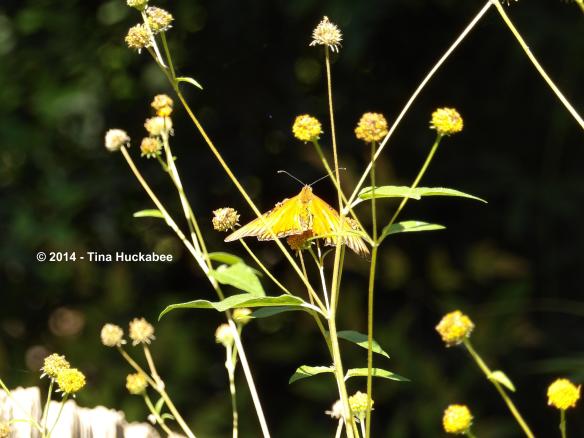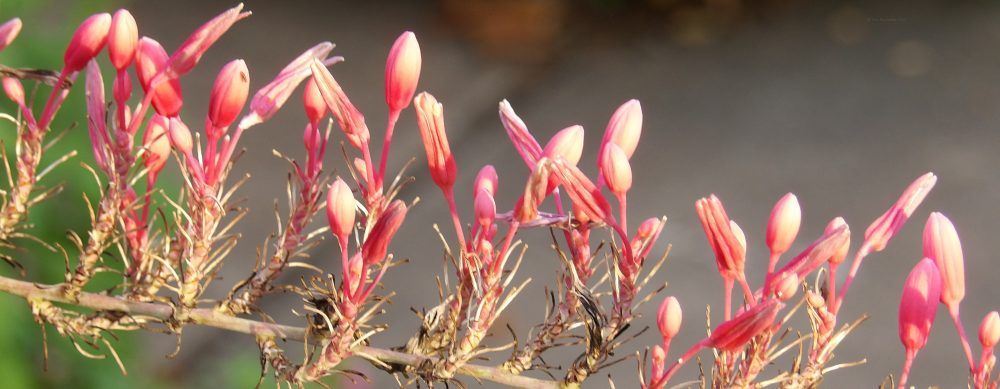Another month gone and my garden, like many others, hosted fabulous wildlife. Nothing particularly unusual flitted through or crawled around my gardens, but expected and welcomed visitors continue to complete the garden and confirm its purpose with their presence. Today is December’s Wildlife Wednesday and those who promote and plant for wildlife share stories and wild happenings in their gardens–appreciating the role that the urban and suburban garden plays in helping to maintain the diversity of our increasingly challenged natural world.
Autumn is usually a good time for butterflies in Central Texas and though there are not quite the numbers or varieties that were common in the past, butterflies still pollinate and grace my gardens and surrounding areas. If October was the month for Monarchs, November starred the Gulf Fritillary, Agraulis vanillae. Most days, I observed at least one Gulf Fritillary–nectaring or flying fast through the gardens. This one rested on a Goldeneye seed head early one morning.
He was there for a while–newly emerged, with drying wings. Gulf Fritillary have beautiful underwing markings and look at that cute face!
This sun-splashed Fritillary rested on spent Goldeneye blooms late one brilliant afternoon. Autumn sun shining bright and low in the sky, the signature pumpkin color typical of the Gulf Fritillary was blanched to a yellow-orange.
On a softer day, this one better represented the natural coloration of Gulf Fritillaries.
And these two, canoodling on the Coral Honeysuckle vine, were doing their part to assure more of these lovelies in the future.
The host plant for the Gulf Fritillary larvae are various passion flowers. I grow Purple Passionflower or Maypop, Passiflora incarnata and Blue Passionflower Passiflora caerulea. I forget to check out the caterpillar action on the foliage of those vines but rest assured, there’s usually at least one caterpillar, munching away.
I’ve chronicled the saga of nannying some Queen butterfly, Danaus gilippus, caterpillars (and one Monarch–sniff, unsuccessfully) in my home at the onset of our first hard freeze. This was the first one brought indoors.
Buddha-fly cat!
I found this colorful Great Purple Hairstreak, Atlides halesus, stunned with cold and barely moving on the asphalt in front of my house the morning after that first freeze.
I brought him inside the house, planning to do…I wasn’t quite sure what, with him. I’d clipped some blooming Purple Coneflower and red Tropical Sage ahead of that forecasted killing freeze and I was glad to have something for this rescued insect to sip from.
I kept tabs on him for a couple of hours that morning before I left the house and he didn’t fly, though he perked up on the blooms-crawling around and tasting.
 When I returned later, no hairstreak graced the floral arrangement. I searched the house, but never found him–or his remains. If he ended up behind a bookshelf, I’m likely to never find his remains–at least not for a long time.
When I returned later, no hairstreak graced the floral arrangement. I searched the house, but never found him–or his remains. If he ended up behind a bookshelf, I’m likely to never find his remains–at least not for a long time.
The larval food of Great Purple Hairstreak is Mistletoe and trees such as Live Oak, Hackberry, and Juniper host that parasitic plant and there are plenty of those trees in my neighborhood. The adult Hairstreak, like many adult butterflies, feed on a variety of flowers.
This spider built a lovely web over my pond and I probably wouldn’t have noticed it if I hadn’t been lounging in my swing chair one sunny Sunday afternoon.
 I don’t know what kind of spider this is. I’m hazarding a guess that she’s in the Pisauridae family of Nursery and Fishing spiders because they’re often found near water sources and their bodies tend to be long and slender.
I don’t know what kind of spider this is. I’m hazarding a guess that she’s in the Pisauridae family of Nursery and Fishing spiders because they’re often found near water sources and their bodies tend to be long and slender.
That same afternoon, a male Neon Skimmer, Libellula croceipennis, hung around the pond, landing just so, seemingly begging for me to take his photo.
He posed well for this member of the garden paparazzi.
I don’t always get good photos of Cardinal birds, Cardinalis cardinalis, though they’re common visitors to my gardens. There are two nesting couples every year around my property, though not on my property. But they regularly visit at the bird feeders and plants which provide protection and food. This handsome gentleman serenaded early one morning and I pleasured in both in snapping his photo and enjoying his song and beauty.
My garden enjoyed a variety of wild visitors this past month and I’m sure yours did too. Please join in posting about the wildlife in your gardens for December Wildlife Wednesday. Share the rare or mundane, funny or fascinating, beneficial or harmful critters you encounter. When you comment on my post, please remember to leave a link to your Wildlife Wednesday post so we can enjoy a variety of garden wildlife observations.
Good wildlife gardening!

















Oh my – that first photo…I was lost in admiration for quite some time before I could wrest my eyes away to continue reading. Simply gorgeous. Honestly, I’d never thought to bring a cold-stunned butterfly into the house that way, though it makes perfect sense. I’d have to protect against our cats however, who would certainly take the opportunity to play. As it turns out it isn’t just me but rather all the pets, even in my extended family, who are enthusiastic butterfly chasers. You can read a little more about that here, in my WW post for this month:
http://austinagrodolce.blogspot.com/2014/12/cloudy-with-chance-of-sulphurs.html
LikeLike
That Fritillary posed beautifully that morning. I love the undersides of their wings–that color combinations is stunning, I think. I wish I knew what happened to the hairstreak. I don’t think the cat(s) got him, but it’s possible. I haven’t moved (nor will I, anytime soon) bookshelves–that’s where he is, I suspect. It’s weird–I don’t like most insects indoors (duh!), but I’m quite tolerant of butterflies, caterpillars, spiders, ladybugs….
Thanks for participating in Wildlife Wednesday!!
LikeLike
The different patterns on the frittilary are so fascinating to observe. You are the best butterfly host, I enjoy your stories on caring for them. It’s wonderful to have butterflies most of the year in our climate too. Cardinals sure do brighten the garden this time of year.
I’ve gone back a few months to catch up on a few that missed previous posts
http://rockoakdeer.blogspot.com/2014/12/wildlife-wednesday-december-2014.html
LikeLike
It’s been an interesting process, this business of butterfly raising–I learned a lot which will benefit me (and any butterfly charges) in the future. Cardinals brighten at every time of the year, but you’re correct, they are a welcomed sight in winter.
Thanks for stopping by!
LikeLike
Pingback: Wildlife Wednesday: December | Under the Pecan Leaves
I love this event so much. Thanks for hosting, Tina.
How amazing that you captured the silver of the fritillary. Nice! I love the grumpy funny faces of butterflies. The purple hairstreak is new to me. Thanks so much for sharing it and all the others.
I think you are so right to note that enjoying wildlife doesn’t have to involve finding rare things but in appreciating the expected.
You definitely won’t find anything rare in my post. Just a round up of the usual suspects
http://mylandrestorationproject.wordpress.com/2014/12/03/wildlife-wednesday-december/
LikeLike
The fritillary posed just perfectly that morning–I was coming home from walking my dog, saw the butterfly and ran into the house–you know the rest of the story. I haven’t seen a Great Purple Hairstreak in a while, but I’m glad I found that one.
As far as wildlife goes, I’ve grown to appreciate even the mundane in the garden; the life cycles and drama of their lives and escapades is important–in the micro and macro of this world.
Thanks for participating in Wildlife Wednesday!
LikeLike
Thanks again for hosting. =)
LikeLike
You’re welcome!
LikeLike
What a great story and pictures! I hope you find that Hairstreak. I’ve been rescuing wasps, too, feeling so sad about them. Even if it’s Wildlife Wednesday, I know our wildlife appreciate our efforts every day, all year!
LikeLike
Hah! I’ve given up on the hairstreak–I’ll find him the next time I vacuum behind a bookshelf–which could be quite some time. 🙂 I’m impressed that you’re rescuing wasps–they sting!! I do feel badly about those late season critters who get caught in the winter winds. They have so many hurdles to jump for their survival, it seems very unfair that there’s another.
LikeLike
Oh my Tina how wonderful to see the butterflies and dragonflies and other lovely critters now gone or sleeping here in our cold garden. We finally arrived home from AZ last night so I am finally linking in with my latest critter story:
LikeLike
Our long summers do have an upside–mild winters! Thanks for participating in Wildlife Wednesday, Donna.
LikeLike
Pingback: A Book Review. Merry Hall by Beverley Nichols. | The Blooming Garden